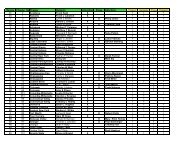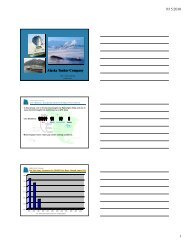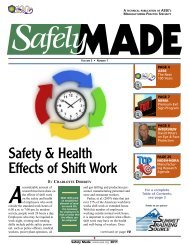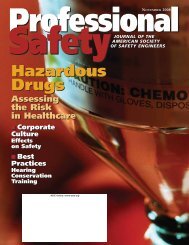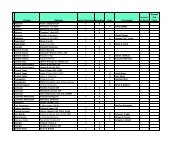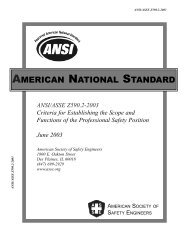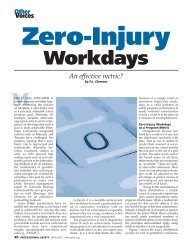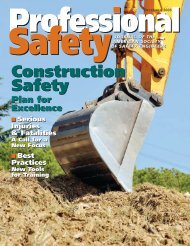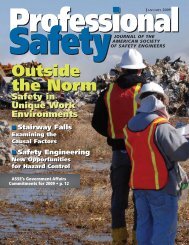OSHA's Flame-Resistant Clothing Policy - ASSE Members
OSHA's Flame-Resistant Clothing Policy - ASSE Members
OSHA's Flame-Resistant Clothing Policy - ASSE Members
Create successful ePaper yourself
Turn your PDF publications into a flip-book with our unique Google optimized e-Paper software.
Directorate of Enforcement Programs informed theAshland Specialty Chemical Company that it could becited when “. . . the employer has not conducted a hazardassessment” to determine the need to use FRC.OSHA’s response to Ashland was supported by expertiseoffered from two recognized third-party organizations, onefrom the National Fire Protection Association (NFPA) andanother from the Center of Chemical Process Safety(CCPS) under The American Institute of Chemical Engineers(AIChE). In the much earlier Ashland FRC interpretation,OSHA states that enforcement of “(t)he specificstandards related to when industrial personnel must useflame-resistant garments/FRC are found in Chapter 4 (referringto Annex A of NFPA 2113) and include mandatoryrequirements for the selection process and a workplace hazardassessment.” Most safety professionals would agree thatthe Ashland interpretation is consistent with methods appliedby general industry (i.e., the use of a hazard assessment).In the Ashland FRC interpretation, OSHA refers guidancefrom CCPS (quoting OSHA), “. . . PPE is not a primarydefense against hazards. They state that directhazard control through engineering and administrativecontrols must come first. PPE is then used as a supplementalmeasure against hazards” (American Institute ofChemical Engineers, 1992).Both NFPA and AIChE offer methods produced by committeesand professionals that are technically sound andoften reflect participation from a wide cross-section ofindustry (e.g., manufacturer, employer/users, installer/maintainer, labor representatives, applied researchers/test labs,enforcing authority, insurers, consumers and special experts.).From these organizations and others, consensus standardsemerge, such as ANSI/API RP 754, “Process SafetyPerformance Indicators for the Refining and PetrochemicalIndustries,” which was issued in April 2010 in part as aresult of the U.S. Chemical Safety and Hazard InvestigationBoard investigation of the 2005 BP Texas City incident.The oil and gas industry is not only an active participantin such standards, but is often the leader in process safety.Numerous standards pertaining to safety and environmentalprotection exist through the American PetroleumInstitute (API). Hazard assessment is a standardized approachused to identify and control risk and is advocatedby not only the higher-risk industries to which OSHAenforcement efforts are directed, but also by internationallyrecognized consensus organizations (i.e., the subject matterexperts).OSHA continues to validate the hazard assessmentapproach where in the most recent interpretation onthe matter a response is given to the InternationalAssociation of Drilling Contractors (IADC) dated Oct.19, 2010, which states, “When an employer conducts ahazard assessment (HA) per NFPA 2113, Chapter 4, oruses some other method to determine the need for wearingFRC as protection against flash fire hazards, OSHACSHOs will evaluate the adequacy of the HA or othermethods in determining whether to issue citations whereemployees are not provided with, or wearing FRC duringdrilling, well-servicing and production-related operations.OSHA expects employers’ HAs or other methodsused to determine the need for FRC to be comprehensiveand robust.” IADC’s interpretation lists multiple factorsfor consideration of a “comprehensive and robust” hazardassessment, and in particular, this one comment:“Note low-probability/high-consequence eventscan occur when engineering and administrative controlsfail. The recent Deep Water Horizon off-shore drillingplatform event resulted in a massive well blowout,explosion/fire resulting in the death of 11 workers,injuries to other workers and immenseenvironmental damage. Eventhough several investigations are stillongoing, preliminary findings showthat a number of engineering andadministrative controls failed leadingto the incident.”There is no question that protectionof people, our communities andthe environment is of paramountimportance. The question is rather,“What is the appropriate basis ofsafety in which we can work andlive?” Intuitively, decisions need to bebased on “providing an environmentthat is free from recognized hazards”;however, it is the author’s opinionthat recognizing a hazard and theassociated severity and likelihood(i.e., risk) of the outcome is notunderstood by most organizations andrequires specific skills.MANAGEMENT SYSTEMSManagement systems, which advocate hazard identificationand control (e.g., OHSAS 18001, ANSI Z71,RC14001, ISO14001, etc.), are tools that organizationscan use to limit risk. Subsequent to the events in Alaska’sPrince William Sound during the Exxon Valdez spillin 1989, Exxon implemented an operations integritymanagement system, a framework similar to ResponsibleCare® 14001, which consists of 11 elements that createa system to implement safety, security, health, environmentand product safety policies.Exxon has reported that its incident rate per 200,000work hours dropped to 0.35 in 2009 from 0.43 the yearbefore; however, risk management to reduce “everyinjury,” “all hazards” and even “residual risk” requiresadvanced expertise often combining multiple disciplines(e.g., finance, safety, risk, insurance, security, environment,etc.). A low-probability/high-consequence riskresulting in catastrophic proportions, such as the DeepWater Horizon event, is not something that most safetyprofessionals, risk managers and loss prevention professionalscould prevent without a concerted effort amongHazard assessment isa standardized approachused to identifyand control riskand is advocatedby not only the higher-riskindustriesto which OSHAenforcement effortsare directed, but alsoby internationallyrecognized consensusorganizations.21Well Informed www.asse.org 2011




